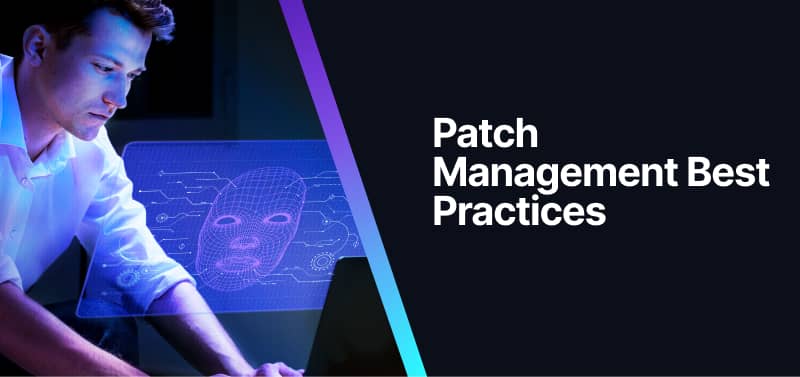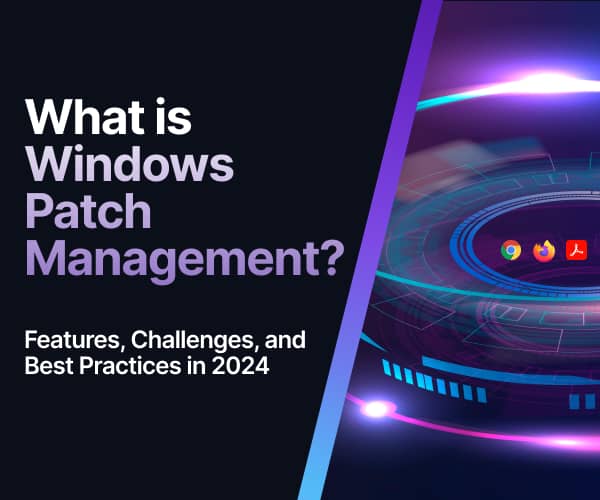What is Windows Patch Management? Features, Challenges, and Best Practices in 2024
The Equifax data breach in 2017 was a major wake-up call. It showed how important it is to update systems regularly. Equifax, a big credit reporting company, was hit hard. The breach exposed the personal information of 143 million people! It happened because Equifax didn't fix a vulnerability in the Apache Struts web application framework. They didn't patch it quickly.

Keeping Windows systems up-to-date is called Windows Patch Management. But let's be real: it's not easy and comes with its own set of challenges. IT teams always have to catch up with a lot of updates. Security Navigator’s research shows that businesses take an average of 215 days to fix known vulnerabilities.
In this blog, Easy2Patch experts will tell you about Windows Patch Management in 2024. We'll explore its features, challenges, and the best practices to handle it. We're here to keep you informed and make sure your systems stay safe.
Let's start by understanding 'What Is Windows Patch Management?' It lays the foundation to comprehend its features, significance, and challenges.
What is Windows Patch Management?
Managing Windows patches means maintaining your computer's health. IT professionals employ Windows patch management as a proactive strategy. These patches/updates keep your system secure, improve performance, and fix any bugs. Let's simplify the different types of updates you'll find in Windows patch management:
- Security updates protect the system from external threats. They address vulnerabilities that hackers could potentially exploit.
- Critical updates fix bugs and glitches that might slow things down. They tackle specific non-security-related bugs.
- Service packs bundle together a range of updates and improvements for the Windows operating system.
- Feature updates introduce new functionalities and enhancements.
- Driver updates enhance the compatibility, stability, and performance of hardware components.
You must also consider that the process of managing Windows patches involves several steps. Let's break them down:
- Identification: recognizing available updates from Microsoft, third-party vendors, or in-house developers.
- Testing: ensuring updates don't disrupt system functionality.
- Deployment: implementing updates across Windows OS, applications, and other components.
Actively addressing security vulnerabilities through Windows patching reduces the risk of security breaches, data loss, and other catastrophic events. Moreover, maintaining compliance with regulatory standards is essential for organizations to avoid penalties and uphold trust with stakeholders. Furthermore, embracing innovation through software updates enhances productivity and ensures that organizations remain competitive.
The importance of Windows patch management cannot be overstated. So vital is this aspect that we've devoted not just one but two blog posts to go deeper into its significance: What are the Cybersecurity Risks Associated with Outdated Software and Operating Systems? and Why It's Important to Keep Software Up-to-Date. We highly encourage you to explore these resources for a deeper understanding.
Microsoft MVP - [Enterprise Mobility] Technical Architect / Consultant - BT Enterprise
“Patching Windows is critical to ensuring your business operates at its optimal level. Windows is great but hackers are always searching to exploit any possible incompatibilities or errors that anti-malware or antivirus software can't always protect. Typical reasons for maintaining an up to date Windows system include, protecting your system from malicious software, to resolve existing Windows issues and unrecognized bugs or it may simply be to maintain systems for regulatory reasons. I would always advise to maintain a separate system on which to test the patching first, especially in an enterprise environment. This is mainly to ensure that all your deployed applications and current Windows settings operate as expected.”
Now that you have gained insight into the basics, let's see what features a patch manager software has to offer. Windows patch management software helps keep your software secure and performing at its best by applying updates from vendors.
Key Features of Effective Patch Management Software
Managing patches isn't easy, especially when you're dealing with a myriad of software across different setups. That's where patch management software comes in to save you. Patch management software simplifies keeping software secure and up-to-date across different environments. Understanding its key features helps you make informed decisions, tailor your patch management strategy, and protect your digital assets and reputation. Here are some key features that define such software. Let's break it down:

- Easy Patch Deployment Automation: These tools are all about efficiency. They automate the entire patching process, from vulnerability detection to Windows patch deployment. It means fewer disruptions and smoother sailing when it comes to system maintenance.
- Keeping Up with Regulations: Staying on the right side of regulations like GDPR, HIPAA, and PCI-DSS is crucial. These software solutions help you stay compliant and keep meticulous records, so you're covered legally and uphold service level agreements (SLAs).
- Adaptable Platform Support: Whether you're working on Windows, macOS, or Linux, an effective patch management solution will offer broad platform compatibility. These software solutions give you the chance to tackle vulnerabilities across different operating systems and third-party apps.
- Stronger Security Measures: Security is of paramount importance in patch management. These solutions bolster system security and strengthen resilience against cyber threats. These days, advanced threat detection capabilities are becoming increasingly standard. Because they empower organizations to proactively protect themselves from potential breaches.
- Sandbox Testing: Before network-wide patch deployment, it's wise to conduct rigorous testing in controlled environments. Sandbox testing ensures compatibility with existing infrastructure and business services, reducing the risk of unexpected hiccups.
- Centralized Patch Deployment: Managing patches becomes a breeze when everything is centralized. With remote deployment capabilities, organizations can ensure uniformity and efficiency across all systems.
- Comprehensive Systems Inventory: Patch management software helps you identify what patches your system requires. You don't have to patch what you don't know about! So, this feature provides a comprehensive view of the network's health and security status, enabling informed decision-making.
- Compliance Support: Meeting regulatory requirements is non-negotiable. In addition to major regulations, some patch management solutions go above and beyond. They cater to various industry needs and diverse industry requirements.
- Flexible Update Options: One size doesn't fit all when it comes to patch management. Whether you prefer automated updates or on-demand patches, these solutions give you the flexibility to tailor your patch management strategies to your specific needs and priorities.
- Ready-to-Use Templates for Patches, Policies, and Documentation: Templates streamline processes and ensure consistency across systems, making deploying patches a breeze.
- Built-in Security Monitoring and Troubleshooting: Some solutions come with monitoring and troubleshooting features to swiftly identify and resolve issues, minimizing downtime and enhancing operational efficiency.
- Simple Integration with Third-Party Applications: Integration with third-party applications, such as Easy2Patch Third-Party Patch Management, ensures your entire software ecosystem stays safe and sound, boosting your cybersecurity posture.
The rise in cybercrime makes patch management a critical focus for IT professionals. Ideally, patch management should be straightforward. However, the reality is much more complex! In the next section we will break down some of the most important challenges of patch management in 2024.
Patch Management Challenges
IT teams face a constant flow of updates and often struggle to keep up. Security Navigator's research shows that businesses take an average of 215 days to patch a known vulnerability. The stakes are high. A Ponemon Institute study found that 42% of organizations that experienced a data breach did so because they did not apply an available patch for a known vulnerability.

Patch management is difficult. It involves balancing demands from IT, security, management, and end users. It covers a range of issues, including operating system updates and upgrades, browser updates, and third-party software patches. Each type requires different strategies. The strategies also vary depending on the platform, such as macOS, Windows, Linux, mobile devices, and servers.
Let’s break down some of the most challenging issues in patch management in 2024:
1- Time-Consuming Patching Processes:
Patching takes time, especially when done manually. As an organization grows, managing patches becomes harder. It's a complex task and can lead to prolonged patch cycles and human mistakes. What is the consequence? Security vulnerabilities.
2- Lack of Endpoint Visibility:
Effective patch management requires comprehensive visibility into all endpoints within the network. If IT professionals can't have a clear insight into each device, they can’t patch all the endpoints right. So, what is the consequence of lack of visibility? Missed patches and potential security gaps. This makes the network vulnerable to attacks.
3- The Rise of Hybrid and Remote Workforces:
More people have been working from home since 2020. This makes patching harder because we have to patch devices that aren't always connected to our network. IT teams must locate, access, and patch devices that are outside the traditional network perimeter. Consequently, new tools and strategies are required to manage devices that may not consistently connect to the corporate network.
4- Shortages of IT Staff:
There aren't enough skilled IT people, especially in security. Shortage of staff exacerbates the challenges of patch management. With fewer resources, IT teams can't keep up with patching because there aren't enough hands to do the work.
5- Diverse Systems and Applications:
Organizations often use many different systems, and each one needs specific patches. This diversity makes it challenging to keep track of all the patches we need and when to install them.
6- Patch Prioritization:
Organizations have to decide which patches are most urgent. IT teams need to assess the risk associated with each vulnerability. This prioritization is not always easy. It requires a deep understanding of the organization’s IT environment. Without this understanding, they can't keep the systems safe.
7- Legacy Systems:
Many organizations continue to operate legacy systems. These systems are old and out of date. It means these systems are more vulnerable to attacks. They are also harder to patch because they are not compatible with current updates.
8- User Education and Compliance:
Organizations need to make sure everyone understands why patching is important and complies with protocols, such as not delaying updates. If they don't educate the staff, even the best patch management strategies can fail, and their systems could be at risk.
9- Patch Rollbacks:
Sometimes patches cause unintended issues, and IT teams have to undo them. Rolling back a patch is a complicated process that requires careful testing to make sure it doesn't make things worse.
10- Ongoing Monitoring:
Continuous monitoring is essential to make sure patches are applied correctly and function as they should. IT teams must track the status of all patches and identify any issues that arise. If something goes wrong, we need to fix it fast to keep our systems safe.
Even with all the challenges in patch management, there's always a solution. Now, let's tackle those challenges and explore some effective Windows patch management best practices.
Patch Management Best Practices
Despite all the challenges, you are going to make a strong patch management system. This will help you enhance security, reduce risks, and keep your IT infrastructure reliable. Below are some key best practices for effective patch management. However, patch management best practices are so important that we've dedicated a whole blog post to it. Check out "Patching Up Security: 13 Best Practices for Patch Management in 2024" to keep your systems secure and up-to-date.

- Assessing and Prioritizing Patches: Always evaluate the risk level of vulnerabilities. Prioritize patches based on how severe and impactful they are. Stay updated with vendor announcements to address critical vulnerabilities quickly. This practice helps you focus your resources on the most urgent issues first.
- Testing Patches Before Full Deployment: Test patches thoroughly in a controlled setting before deploying them. This one is a critical practice that helps you catch any conflicts or issues early. By doing this, you can avoid problems when the patches go live.
- Ensuring Backup Systems: Even with thorough testing, patches can sometimes cause issues. Regularly backup your systems so you can recover quickly if something goes wrong. This step minimizes downtime and keeps your operations running smoothly.
- Regularly Updating and Reviewing Patch Management Policies: Keep your patch management policies updated. Maintain a current inventory of your systems and software. Communicate clearly with your teams about patching schedules and procedures. Document the status of patch deployments and note any deviations from the norm. Use dedicated tools to track progress and keep an audit trail. This practice helps you stay organized and ensures accountability.
The Role of Third-Party Patch Management Solutions for Windows
What is the difference between in-built Windows Update and third-party solutions?
Windows Update for Business (WUfB) is a Microsoft service that provides updates for Windows OS and related applications. It does not update third-party products. For those updates, you need an on-premises solution like Microsoft Endpoint Manager Configuration Manager.
Third-party patch management tools handle updates for apps not made by the OS or device manufacturer. They fix software bugs, and security vulnerabilities, and add new features. This keeps various software applications secure and running smoothly.
What are the benefits of using a third-party tool?
Third-party tools offer many benefits:
- Extended Control: They let you manage updates for third-party applications from one central place.
- Comprehensive Coverage of Non-Microsoft Software: They automatically update a wide range of applications.
- Advanced Scheduling Options: They allow you to schedule patches to ensure timely updates and better security.
- Cost-Effective: They save money since you don’t need to build, implement, and maintain your own solution.
- Risk Management: They help you manage the risks of creating your own patch management tool.
- Boost Productivity and Save Time: They automate updates, which frees up time and boosts productivity.
How does Easy2Patch help?
Easy2Patch is a software solution for updating third-party products on computers within IT infrastructures. It integrates with WSUS, ConfigMgr, and Intune. It focuses on third-party updates for Windows Operating Systems.
Easy2Patch offers automated and centralized third-party patch management. It saves time, labor, and money while improving IT security. Easy2Patch provides:
- Automated patching
- Centralized patch control
- Reliable patch deployment
- Compliance with patching policies
- Patching for distributed and remote environments
- Agentless patching
- Customized patching
When it comes to third-party patch management, make it easy with Easy2Patch!
Get started with our patch management software for free
Get 30 Day Premium TrialExpert Advice on Windows Patch Management
Head - IT | IT & OT Operations | Business Process Atomization | ERP | IT Infra | IT Security & Compliance | IT Strategies | IT Projects
“Automatic updates, prioritizing critical and security updates, regularly checking for updates, keeping third-party software updated, utilizing tools like WSUS for enterprise environments, implementing a patch management policy, regularly backing up systems, testing patches in a controlled environment, monitoring and auditing systems, educating users on the importance of updates, utilizing ATP tools, implementing network segmentation, considering virtual patching solutions, and staying informed about the latest security vulnerabilities and updates.”
Managed services, Service Delivery, Operations Management
“Optimizing the Windows patching procedure involves transitioning from manual updates for servers with prolonged unpatched periods to an automated system. Coordinate with the security team to facilitate internet access exclusively during patch installations, mitigating potential attacks. This proactive approach enhances overall system security.”
Juniper Networks Ambassador | JNCIE-SEC #374 | Juniper Mistfit | Author | IoT Vendor
“Patching Windows security effectively and securely is crucial for maintaining a secure and resilient system. Employ a robust patch management system, prioritizing critical updates that address high-risk vulnerabilities. Regularly update third-party software, such as browsers and plugins, to mitigate potential security risks. Utilize tools like Microsoft Baseline Security Analyzer (MBSA) to identify and address security misconfigurations. Additionally, stay informed about emerging threats, and, if needed, seek professional assistance to enhance your system's security posture.”
Microsoft MVP - [Enterprise Mobility] Technical Architect / Consultant - BT Enterprise
“Patching Windows is critical to ensuring your business operates at its optimal level. Windows is great but hackers are always searching to exploit any possible incompatibilities or errors that anti-malware or antivirus software can't always protect. Typical reasons for maintaining an up to date Windows system include, protecting your system from malicious software, to resolve existing Windows issues and unrecognized bugs or it may simply be to maintain systems for regulatory reasons. I would always advise to maintain a separate system on which to test the patching first, especially in an enterprise environment. This is mainly to ensure that all your deployed applications and current Windows settings operate as expected.”
Conclusion
Windows Patch Management is about keeping your Windows systems up-to-date. This process involves applying security updates, critical updates, service packs, feature updates, and driver updates. It helps maintain security, improve performance, and fix bugs. Managing these patches is not easy, and IT teams often struggle with it.
Effective Windows Patch Management includes several key features. It also comes with many challenges. Despite these challenges, there are best practices to enhance your patch management system. These include assessing and prioritizing patches, testing patches before full deployment, ensuring backup systems, and regularly updating and reviewing patch management policies.
Third-party patch management solutions can also help. They handle updates for apps not made by the OS or device manufacturer. These tools offer extended control, comprehensive coverage of non-Microsoft software, advanced scheduling options, cost-effectiveness, risk management, and improved productivity.
Easy2Patch stands out as an exceptional third-party solution. It integrates with WSUS, ConfigMgr, and Intune. It automates and centralizes third-party patch management, saving time and improving IT security. Easy2Patch provides automated patching, centralized control, reliable deployment, compliance support, patching for remote environments, agentless patching, and customized patching.
Experts in the field emphasize the importance of automated updates, prioritizing critical and security updates, keeping third-party software updated, utilizing tools like WSUS, implementing patch management policies, regularly backing up systems, testing patches in controlled environments, monitoring systems, educating users, utilizing ATP tools, and staying informed about the latest security vulnerabilities and updates.
Frequently Asked Questions
Yes, Microsoft offers several patch management tools. Azure Update Manager helps manage updates for machines running Windows and Linux across Azure, on-premises, and other cloud platforms. Windows Autopatch is another tool that automates updates for Windows, Microsoft 365 Apps for enterprise, Microsoft Edge, and Microsoft Teams.
Yes, Windows Server Update Services (WSUS) is a patch management tool from Microsoft. It allows IT administrators to deploy the latest Microsoft product updates.
Yes, System Center Configuration Manager (SCCM), now called Microsoft Endpoint Configuration Manager, is a Microsoft tool. It helps administrators manage the deployment and security of devices and applications across an enterprise.
You can ensure compatibility by thoroughly testing patches in a controlled environment before deployment. Use automated Windows patch management tools to identify compatibility issues as well.
To overcome these challenges, schedule patch deployments during off-peak hours. Use automated patch management tools. Keep an updated inventory of all systems.
Use a centralized patch management dashboard to monitor patch compliance. Maintain an inventory of software and hardware. Conduct regular reviews.
Patch management covers updates for operating systems, application code, and embedded systems, including servers. It also includes updates for browsers and third-party software.
Automated patch management is more efficient and secure than manual patching. It ensures consistency and reduces human intervention. It provides efficiency and accuracy in rolling out system updates and patches. Automated tools work continuously to find and fix system issues quickly.
Challenges include timing and operations equilibrium, patching complexity, resource availability, and compatibility constraints. Other challenges are patch prioritization, diverse systems and applications, legacy systems, user education and compliance, patch rollbacks, ongoing monitoring, and remote work.
Best practices include building an inventory of all active software, limiting the types of software to reduce third-party risk, and classifying systems based on risk to inform patch strategy and update priorities. Prioritize vendor patch announcements for immediate processing. Establish a patch management policy, automate deployment, prioritize urgent vulnerabilities, test patches thoroughly, maintain an updated inventory, create a rollback plan, enforce least privilege access, monitor and audit compliance, and train employees.
Prioritizing vulnerabilities is crucial because it allows IT teams to address the most critical security risks first. This approach helps mitigate the potential impact of a security breach and ensures that significant vulnerabilities are promptly addressed.
IT Automation Key Benefits and Best Practices

What Is Vulnerability Management?

Ultimate IT Risk Management Guide 2024: Best Practices, Strategies, and Tools

Best Practices for IT Infrastructure Management in 2024

What is Windows Patch Management? Features, Challenges, and Best Practices in 2024

What are the Cybersecurity Risks Associated with Outdated Software and Operating Systems?





